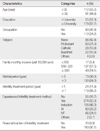Abstract
Purpose
The purpose of this study was to test a model for quality of life among infertile women. This model was based primarily on the concept of the Fertility Quality of Life by Boivin et al. (2011) and the Infertility Resilience Model by Rindenour (2009).
Methods
Fifteen measurable variables were used to estimate quality of life. They included endogenous variables such as fertility quality of life and resilience, and exogenous variables such as infertility related stress, depression, marital adjustment, and family support. Data sets (n=203) used for analysis were collected in a general hospital which had, on average, 400 assisted reproductive technologies per month.
References
1. Aarts JW, van Empel IW, Boivin J, Nelen WL, Kremer JA, Verhaak CM. Relationship between quality of life and distress in infertility: A validation study of the Dutch FertiQoL. Hum Reprod. 2011; 26(5):1112–1118. http://dx.doi.org/10.1093/humrep/der051.
2. Beck AT. Depression: Clinical, experimental, and theoretical aspects. New York, NY: Hoeber;1967.
3. Boivin J, Takefman J, Braverman A. The fertility quality of life (FertiQoL) tool: Development and general psychometric properties. Hum Reprod. 2011; 26(8):2084–2091. http://dx.doi.org/10.1093/humrep/der171.
4. Chachamovich JL, Chachamovich E, Ezer H, Cordova FP, Fleck MM, Knauth DR, et al. Psychological distress as predictor of quality of life in men experiencing infertility: A cross-sectional survey. Reprod Health. 2010; 7:3. http://dx.doi.org/10.1186/1742-4755-7-3.
5. Chachamovich JR, Chachamovich E, Zachia S, Knauth D, Passos EP. What variables predict generic and health-related quality of life in a sample of Brazilian women experiencing infertility? Hum Reprod. 2007; 22(7):1946–1952. http://dx.doi.org/10.1093/humrep/dem080.
6. Choi SI. Validity and reliability of the revised Dyadic Adjustment Scale. Gho Hwang Ronjib. 2004; 35:97–114.
7. Cohen S, Hoberman HM. Positive events and social supports as buffers of life change stress. J Appl Soc Psychol. 1983; 13(2):99–125.
8. Domar AD, Zuttermeister PC, Friedman R. The psychological impact of infertility: A comparison with patients with other medical conditions. J Psychosom Obstet Gynaecol. 1993; 14:Suppl. 45–52.
9. Gameiro S, Moura-Ramos M, Canavarro MC, Santos TA, Dattilio FM. Congruence of the marital relationship during transition to parenthood: A study with couples who conceived spontaneously or through assisted reproductive technologies. Contemp Fam Ther. 2011; 33(2):91–106.
10. Gourounti K, Anagnostopoulos F, Vaslamatzis G. Psychometric properties and factor structure of the fertility problem inventory in a sample of infertile women undergoing fertility treatment. Midwifery. 2011; 27(5):660–667. http://dx.doi.org/10.1016/j.midw.2010.02.007.
11. Hair JF, Black B, Babin B, Anderson RE, Tatham RL. Multivariate data analysis. 6th ed. Upper Saddle River, NJ: Prentice Hall;2006.
12. Herrmann D, Scherg H, Verres R, von Hagens C, Strowitzki T, Wischmann T. Resilience in infertile couples acts as a protective factor against infertility-specific distress and impaired quality of life. J Assist Reprod Genet. 2011; 28(11):1111–1117. http://dx.doi.org/10.1007/s10815-011-9637-2.
13. Kim HS, So HS. A prediction model development on quality of life in kidney transplant recipients. J Korean Acad Nurs. 2009; 39(4):518–527. http://dx.doi.org/10.4040/jkan.2009.39.4.518.
14. Kim SK, Kim YK, Cho AJ, Kim HR, Lim SE. The 2009 national survey on fertility, family health and welfare in Korea (KIHASA Report 2009-33). Seoul: Korea Institute for Health and Social Affairs;2009.
15. Lee YH, Song JY. A study of the reliability and the validity of the BDI, SDS, and MMPI-D scales. Korean J Clin Psychol. 1991; 10(1):98–113.
16. Lim SJ, Oh SS, Han GS. Predictors of depression and anxiety among foreign wives through marriage migration. Korean J Woman Psychol. 2009; 14(4):515–528.
17. Mahajan NN, Turnbull DA, Davies MJ, Jindal UN, Briggs NE, Taplin JE. Adjustment to infertility: The role of intrapersonal and interpersonal resources/vulnerabilities. Hum Reprod. 2009; 24(4):906–912. http://dx.doi.org/10.1093/humrep/den462.
18. Matthiesen SM, Frederiksen Y, Ingerslev HJ, Zachariae R. Stress, distress and outcome of assisted reproductive technology (ART): A meta-analysis. Hum Reprod. 2011; 26(10):2763–2776. http://dx.doi.org/10.1093/humrep/der246.
19. Min SW, Kim YH, Cho YR. Stress, depression and factors influencing on quality of life of infertile women. J Korean Soc Matern Child Health. 2008; 12(1):19–32.
20. Monga M, Alexandrescu B, Katz SE, Stein M, Ganiats T. Impact of infertility on quality of life, marital adjustment, and sexual function. Urology. 2004; 63(1):126–130.
21. Newton CR, Sherrard W, Glavac I. The fertility problem inventory: Measuring perceived infertility-related stress. Fertil Steril. 1999; 72(1):54–62.
22. Onat G, Beji NK. Marital relationship and quality of life among couples with infertility. Sex Disabil. 2012; 30(1):39–52.
23. Park YJ. The stress of the infertile women. J Korean Acad Womens Health Nurs. 1995; 1(2):209–221.
24. Peterson BD, Newton CR, Rosen KH. Examining congruence between partners' perceived infertility-related stress and its relationship to marital adjustment and depression in infertile couples. Fam Process. 2003; 42(1):59–70.
25. Ridenour AF, Yorgason JB, Peterson B. The infertility resilience model: Assessing individual, couple, and external predictive factors. Contemp Fam Ther. 2009; 31(1):34–51.
26. Shin YH, Sim MK, Kim TI. Resilience and health-related quality of life in children with chronic illness. J Korean Acad Child Health Nurs. 2006; 12(3):295–303.
27. Spanier GB. Measuring dyadic adjustment: New scales for assessing the quality of marriage and similar dyads. J Marriage Fam. 1976; 38(1):15–28.
28. Suh MJ. The study on factors influencing the state of adaptation of the hamiplegic patients. Seoul: Seoul National University;1989. Unpublished doctoral dissertation.
29. Valsangkar S, Bodhare T, Bele S, Sai S. An evaluation of the effect of infertility on marital, sexual satisfaction indices and health-related quality of life in women. J Hum Reprod Sci. 2011; 4(2):80–85. http://dx.doi.org/10.4103/0974-1208.86088.
30. Wagnild GM, Young HM. Development and psychometric evaluation of the Resilience Scale. J Nurs Meas. 1993; 1(2):165–178.
31. Woo JP. The concept and understanding of structural equation model. Seoul: Hannarae Publishing;2012.




 PDF
PDF ePub
ePub Citation
Citation Print
Print







 XML Download
XML Download